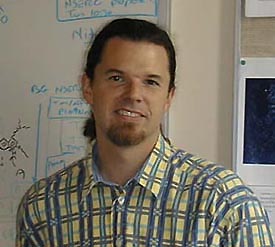Dr. David T. Cramb
The ScienceDaily article Nanotechnology: Entirely New Way Of Storing Gas Created said
“A new process for catching gas from the environment and holding it indefinitely in molecular-sized containers has been developed by a team of University of Calgary researchers, who say it represents a novel method of gas storage that could yield benefits for capturing, storing and transporting gases more safely and efficiently.In a new article in Nature-Materials,* Shimizu, fellow U of C professor David Cramb, chemistry graduate student Brett Chandler and colleagues from the National Research Council describe their invention of ‘molecular nanovalves’. Using the orderly crystal structure of a barium organotrisulfonate, the researchers developed a unique solid structure that is able to convert from a series of open channels to a collection of air-tight chambers.”
David T. Cramb, Ph.D. is Full Professor, Department of Chemistry and Adjunct Professor, Department of Pharmacology and Therapeutics, University of Calgary.
David’s research interests revolve around studying the behavior of aromatic molecules in living cells and models of living cells. His goal is to understand how small changes in molecular structure affect the subcellular partitioning and diffusion behaviour of molecules such as pharmaceuticals and toxins. This information will lead to more relevant molecular uptake data for new drugs during the developmental stage.
His systems of current interest are: Hem-based molecules used in photodynamic therapy. Pyrene and pyrene-derivatives, which are known carcinogens. Indole-based biomolecules such as seratonin and melatonine. In order to follow the behavior of one specific species in the cytoplasm, his research group uses the spectral signature of that species. Depending on their local environment, many molecules, especially aromatics with inversion symmetry, display remarkable changes in their absorption and emission spectra. This is particularly applicable when considering the two-photon absorption cross-section for molecules with high symmetry.
The shifting of absorption and emission wavelengths is exploited to help identify whether molecules find themselves in aqueous media, in the hydrophobic membranes, or bound to cellular proteins. Work is currently being carried out to understand the fundamental two-photon spectroscopy of several biologically relevant molecules in various media.
David coauthored The use of Quantum Dots in Novel Two Photon Excitation Fluorescence Cross Correlation Spectroscopy Ligant Binding Assays, Application of an ex ovo chicken chorioallantoic membrane model for two-photon excitation photodynamic therapy of age-related macular degeneration, Lipid Phase Dependence of DNA-Cationic Phospholipid Bilayer Interactions Examined Using Atomic Force Microscopy, Dynamic behavior of photosensitizers after multiphoton excitation, and the innovative Amazon download Are two photons better than one? Two-photon excitation is a new paradigm in photodynamic therapy, and Canadian research is on top of the latest developments.
David earned his B.Sc. in 1985 at the University of British Columbia and his Ph.D. in Molecular Spectroscopy in 1990 at the University of British Columbia.
